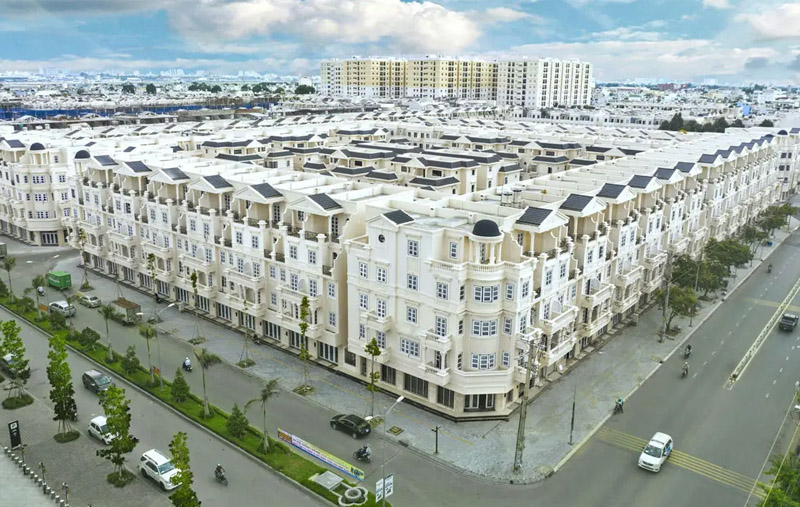What is real estate? Distinguish between 3 types of real estate

Real estate is assets of great value, subject to strict management and regulation by the legal regulatory system. This term is not only widely used in legal documents but also popular in practice. However, not everyone can accurately define what real estate is and understand the legal regulations related to this type of asset.
Table of Contents
1. What is real estate?
Currently, Vietnamese legal documents do not have any regulations specifically defining what real estate is. However, Article 105 of the 2015 Civil Code stipulates:
“first. Assets are objects, money, valuable papers and property rights.
2. Assets include real estate and movable property. Real estate and movable property can be existing assets and assets formed in the future.”
In addition, Article 107 of the 2015 Civil Code stipulates:
“first. Real estate includes:
a) Land;
b) Houses and constructions attached to land;
c) Other assets attached to land, houses, construction works;
d) Other assets as prescribed by law.”

Thus, we can generally understand the concept of real estate as existing assets or assets that may be formed in the future, including: land, housing, construction works attached to land, assets other things attached to land, etc. according to the provisions of law.
2. What attributes does real estate have?
Real estate is a special type of asset with many unique attributes compared to other types of assets. Understanding the attributes of real estate will be necessary to effectively invest, manage and use this type of asset.
2.1. Immobility
Real estate is a commodity with a fixed nature. Even if it is purchased, sold or transferred, it cannot be moved to another location. Instead, the owner only has the right to exploit and use according to the provisions of law. The location of real estate is associated with ecological, economic and social conditions and affects the value of this property. That is also the reason why land prices are different even in the same area.
Real estate cannot be moved
2.2. Heterogeneity
This attribute is demonstrated by the fact that each type of real estate has unique characteristics and no two real estate properties are completely alike. In particular, geographical location will be a factor affecting the value, usability and development potential of real estate. In addition, natural factors such as terrain, climate, and surrounding environment also make a difference for each real estate area. This leads to the ownership, land use rights, and legal documents of each real estate being different.
2.3. Scarcity
The land area and real estate supply are limited, however the population growth rate is constantly increasing. Accordingly, it is impossible to increase the amount of land and natural resources corresponding to human needs for land and housing. Scarcity contributes to the high value of real estate, especially in areas with beautiful locations and abundant resources. This also creates opportunities for investors to own assets that increase in value over time.
2.4. Sustainability
Real estate (including land, houses, constructions attached to land, etc.) has the ability to be used for a long time, bringing great value and benefits. Accordingly, whether using real estate for personal needs or investment or business purposes, it can still bring many benefits to the owner. The possibility of infinite reuse and land ownership also doubles the value of real estate, demonstrating the sustainability of assets in economic life.
Real estate is a sustainable asset
3. Distinguish between 3 types of real estate
What does real estate include? Currently, real estate can be divided into 3 types based on characteristics and properties. As follows:
- Construction real estate: This type of real estate accounts for the highest proportion and is highly complex in the construction real estate group. Including: Land and land-related assets; Infrastructure real estate; Real estate for commercial and service projects, warehouses, factories; Office real estate. The characteristic of this type is investing in construction on land, real estate value depends on location, area, development potential,…
- Real estate without construction investment: This type is mainly agricultural land in the form of production means, which has not been invested in large-scale construction. This includes: forest land, aquaculture land, rare earth types, unused land,…
Forest land is a type of real estate that does not require construction investment
- Typical real estate: Typical real estate types include groups of buildings with cultural and heritage properties such as pagodas, temples, churches, national conservation works, historical relics – culture,… This real estate group hardly participates in market transactions or has a very low participation rate.
4. Real estate terms you need to understand
Thus, we have learned what real estate is as well as the basic attributes of real estate. The real estate market is increasingly vibrant with diversity in types, products and transaction methods. Understanding real estate terms is the first and extremely important step to help you confidently participate in this potential market. Here are a few important terms that investors need to master:
- Real estate project: According to the provisions of Clause 3, Article 3 of the Law on Real Estate Business, a real estate project is a construction investment project for housing business, construction projects, and land use rights. approved by a competent state agency in accordance with the law. These include: investment projects to build housing, urban areas, rural residential areas; Works serving education, healthcare, culture, sports, commerce, services, and accommodation; Technical infrastructure works, industrial park infrastructure;…
- Real estate brokerage: This is an activity in which one party acts as an intermediary for other parties in the sale, transfer, lease, sublease, lease purchase, etc. of real estate (According to Clause 2, Article 3 of the Law on Business). real estate business).
Real estate broker
- Real estate consulting: This is a consulting activity on issues related to real estate business at the request of the parties (Clause 8, Article 3 of the Law on Real Estate Business).
- Real estate business: This is a capital investment activity to build houses, buildings, and land use rights to sell, transfer, lease, sublease, lease purchase real estate or provide real estate services. real estate,… for the purpose of seeking profit (According to Clause 1, Article 3 of the Law on Real Estate Business).
- Real estate trading floor: This term is used to refer to the place where transactions on buying, selling, transferring, leasing, subleasing, and leasing real estate take place according to the provisions of the Law on Real Estate Business.
- Real estate bubble: This term is not regulated in legal documents but is used in practice to refer to the phenomenon of “dizzying” increases in real estate prices. Accordingly, real estate prices can be many times higher than their actual value. However, at a certain point, prices will drop or even cause the real estate market to freeze. This is called the bursting of the real estate bubble.
A real estate bubble is a phenomenon in which real estate prices skyrocket many times over
5. What is the difference between movable property and real estate?
The concept of real estate and movable property plays a very important role in property transactions. However, in reality, many people still confuse these two types of assets. To distinguish the difference between movable property and real estate, please refer to the comparison table below:
| Comparative characteristics | Real estate | Movables |
| Object | According to the provisions of Clause 1, Article 107 of the 2015 Civil Code, real estate includes: – Land;– Houses and construction works attached to land; – Other assets attached to land, houses, construction works; – Other assets as prescribed by law. In addition to the above assets, there are also a number of other types of intangible assets attached to land such as: land use rights, mortgage rights, transfer rights, etc. These are all considered real estate according to the provisions of the Law on Business. real estate business. |
The scope of objects classified as movable property is quite wide. Therefore, the law does not specifically list cases but only generally states: “Movable assets are assets that are not real estate” (According to Clause 2, Article 107 of the 2015 Civil Code). |
| Properties | – An asset that cannot be moved. – Highly sustainable, value increases over time. |
– Is an asset that can be moved. – Subject to wear and tear, value fluctuates over time. |
| Investment purpose | Suitable for long-term investment purposes. | Suitable for short-term or long-term investment purposes. |
| Creditial | Short | High |
| Risk | High | Short |
| Register property rights | Ownership and other rights to real estate must be registered according to the provisions of the 2015 Civil Code and other legal documents on property registration. | Ownership and other rights to movable property are not required to be registered with competent authorities (except in some cases prescribed by law). |
| Ownership | Certificate of land use rights, ownership of houses and other assets attached to land. | Sales contract, receipt… |
| For example | Land, houses, apartments, villas… | Vehicles, machinery, equipment, furniture… |
In addition to the concept of what real estate is, legal regulations related to real estate are also of interest to many investors today. Understanding the legal regulations related to this field is extremely important to protect rights and ensure the safety of real estate transactions.
6.1. Boundaries between real estate properties
Pursuant to Article 175 of the 2015 Civil Code, the boundaries between real estate are specified as follows:
- The boundaries between adjacent real estate properties are determined based on agreement or decision of a competent state agency.
- The boundaries between real estate properties can also be determined according to custom or according to boundaries that have existed for 30 years or more without dispute.
- Land users are not allowed to encroach, occupy or change the boundary markers between real estate properties, even in cases where the boundaries are canals, ditches, ditches, ditches, or field edges.
- Land users are allowed to use the space and underground space vertically from the boundary of the land plot according to the provisions of law, without affecting the land use of others.
- You can only plant trees and carry out other projects within the land under your rights of use, according to the determined boundaries. If tree roots and branches extend beyond the boundaries between real estate properties, root trimming, cutting, and pruning must be carried out (unless otherwise agreed).
Regulations on boundaries between real estate properties
6.2. Landmarks separate properties
Regulations on boundary markers separating real estate properties are clearly stated in Clauses 1 and 2, Article 176 of the 2015 Civil Code as follows:
- Real estate owners are only allowed to erect landmarks, fences, walls or plant trees on land under their rights of use.
- Adjacent real estate owners can agree with each other on erecting landmarks, fences, dividing walls or planting trees on the boundary to act as markers between real estate properties. In this case, boundary markers are considered common property of those subjects.
6.3. Open the door to look at the adjacent property
According to Clause 3, Article 176 of the 2015 Civil Code, it is stipulated:
- For boundary markers that are common house walls, adjacent real estate owners are not allowed to open windows, air vents or perforate walls to place construction structures (unless otherwise agreed by the adjacent real estate owner).
- The opening of the door must also be made in accordance with the dimensions specified in Article 178 of the 2015 Civil Code as follows: “The underside of the canopy over the door and the underside of the canopy on the window facing the common path must be off the ground.” from 2.5 meters or more.”
With the information compiled above, you surely understand what real estate is, what types it includes, and what attributes it has. In addition, understanding and complying with real estate laws will be an important foundation to help invest, manage and use this asset effectively.









